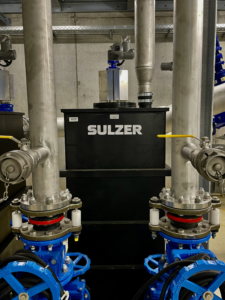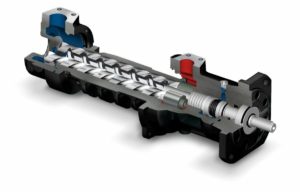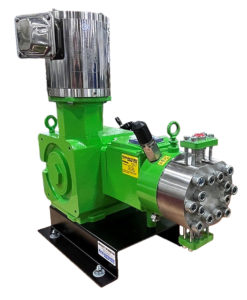Gardner Denver Reports Revenues
Gardner Denver announced that revenues and net income for the twelve months ended December 31, 2005 were $1.2 billion and $67.0 million, respectively; the Company's highest levels since becoming an independent entity in 1994.
Diluted earnings per share (DEPS) for the twelve months of 2005 was $2.74, 43% higher than the previous year. Revenues for the three months ended December 31, 2005 were $369.3 million, a 53% increase compared to the fourth quarter of the previous year, primarily as a result of acquisitions completed in 2005 and strong organic growth.Net income for the three months ended December 31, 2005 was $25.3 million, an 86% increase compared to the same period last year, as a result of the benefit of acquisitions and flow-through profitability on organic revenue growth. Diluted earnings per share for the three months of 2005 was $0.96, 43% higher than the previous year. Cash generated by operations increased 55% to $119 million in 2005, compared to $77 million in the previous year.
Outlook
Looking forward, Mr. Centanni stated, "In 2006, I anticipate further cost reductions and acquisition integration savings. I believe broader implementation of our lean manufacturing techniques will contribute to inventory reductions and production efficiency improvements. Our manufacturing presence in Asia will enable our participation in the continued dynamic growth for industrial products in this region. Manufacturing capacity utilization in the U.S. exceeded the key threshold level of 80% for two consecutive months in the fourth quarter of 2005.Therefore, we enter 2006 with a feeling of cautious optimism that industrial demand will continue to expand, albeit slowly, and positively influence demand for our compressor and vacuum products. We expect that the combination of cost reductions realized through acquisition integration, efficiency improvements, and leverage associated with revenue growth will more than offset the effect of expensing stock options in 2006, resulting in year-over-year operating margin expansion."
"Demand for our drilling and well stimulation pumps is extremely strong and we expect this to continue throughout 2006 and into 2007.To reduce potential manufacturing bottlenecks, we will continue to outsource machining operations to smooth our production processes and we expect to continue to ship product at rates that satisfy our customers' requirements," noted Mr. Centanni.
"Given the current economic environment, as well as our existing backlog and recent order trends, we expect DEPS for 2006 to be approximately $3.25 to $3.45, with first quarter DEPS approximating $0.65 to $0.75.The midpoint of this range ($3.35) represents a 22% increase over the 2005 results. This improvement is expected despite the reduction in DEPS associated with expensing stock options for the first time in 2006 and a greater number of average shares outstanding for the twelve-month period of 2006, as compared to 2005.Based on current expectations for the sources of earnings in 2006, the effective tax rate assumed in the DEPS guidance for 2006 is 30%."
The Thomas Industries acquisition is expected to contribute net income of $8.4 million in 2006, compared to $2.5 million in 2005.However, in 2006, the Company will begin expensing stock options, in accordance with SFAS 123R, which was adopted on January 1, 2006.The after-tax effect of these expenses is estimated to be in a range of $3.6 million to $4.2 million for the year. A disproportionate amount of this expense will be recognized in the first quarter of 2006, due to the number of options held by employees eligible for retirement. The implementation of this accounting standard is expected to reduce net income by $1.7 million to $2.0 million in the first quarter of 2006.These estimates are based on an assumption that the value of the 2005 stock option grant recurs in 2006.
Fourth Quarter Results
Revenues increased $128.1 million (53%) to $369.3 million for the three months ended December 31, 2005, compared to the same period of 2004. Compressor and Vacuum Products segment revenues increased 58% for the three- month period of 2005, compared to the previous year, primarily due to the incremental effect of acquisitions, improved demand for compressor and blower products, especially in the Asian market, and price increases. Fluid Transfer Products segment revenues increased 32% for the three months ended December 31, 2005, compared to the same period of 2004, due to strong organic growth in drilling and well servicing pump shipments and price increases.
Orders exceeded revenues during the fourth quarter and for the full year of 2005, resulting in backlog increases. Orders for the three-month period of 2005 were $146.5 million (60%) higher than the same period of the previous year, due to acquisitions (43%) and organic growth (17%).For the twelve- month period of 2005, orders increased $584.0 million (74%).Acquisitions accounted for approximately two-thirds of this increase, with organic growth generating the remainder.
Gross margin (defined as revenues less cost of sales) as a percentage of sales (gross margin percentage) increased to 34.0% in the three-month period ended December 31, 2005, from 32.8% in the same period of 2004. This improvement was attributable to the benefit of leveraging costs over additional production volume, acquisitions and price increases. Favorable sales mix also contributed to increased gross margin as the fourth quarter of 2005 included a higher percentage of drilling pump sales than the previous year.
Selling and administrative expenses increased $15.7 million in the three- month period ended December 31, 2005 to $67.1 million, due to the incremental effect of acquisitions. Some acquisition-related adjustments were recognized during the fourth quarter, such as reducing pension expense to reflect the most recent actuarial valuations. Year-end adjustments reduced selling and administrative expenses approximately $2.4 million in the fourth quarter of 2005.
Operating earnings for the Compressor and Vacuum Products segment were 10.5% of revenues in the three months ended December 31, 2005, an increase from 7.4% in the same period of 2004.This increase is attributable to margin improvements realized at Nash Elmo since its acquisition, cost reductions initiated at Thomas Industries' operations and year-end adjustments to selling and administrative expenses, partially offset by increased material, compensation and fringe benefit expenses. The Fluid Transfer Products segment operating margin increased to 21.6% for the three months ended December 31, 2005, compared to 16.1% in the same period of 2004.This improvement was attributable to the benefit of cost leverage over a higher revenue base, favorable mix, price increases and operational improvements.
Incremental borrowings necessary to complete acquisitions in 2005 and higher effective interest rates resulted in increased interest expense for the three months ended December 31, 2005, compared to the same period of 2004. The weighted average interest rate for the three-month period of 2005 was 6.9%, compared to 5.0% in the prior year period.
Net income for the three months ended December 31, 2005 increased $11.7 million (86%) to $25.3 million, compared to $13.6 million in same period of 2004.Diluted earnings per share for the three months of 2005 was $0.96, 43% higher than the previous year. The improvement in net income and DEPS was primarily attributable to the incremental benefit of acquisitions, cost reductions and synergy savings, and higher revenue volume and the related leverage of fixed and semi-fixed expenses. These results include approximately $2.7 million of net income from Thomas Industries' operations for the three months ended December 31, 2005.The improvement in DEPS is net of the dilutive effect of the issuance of 5.7 million shares in May 2005 and a higher effective tax rate in 2005 (30%), compared to the previous year. In 2004, the effective annual tax rate was reduced to 29% through a decrease in the fourth quarter effective tax rate to 18%, arising from a one-time favorable tax audit settlement.
Full Year Results
Revenues increased $475.1 million (64%) to $1.2 billion in 2005, compared to $739.5 million in 2004.This increase was primarily due to acquisitions, which contributed $375.5 million in incremental revenues. Increased volume, especially from fluid transfer products, and price increases added to this improvement but were partially offset by changes in foreign currency exchange rates.
Revenues for the Compressor and Vacuum Products segment increased 70% to $1.0 billion in 2005.This increase was primarily due to acquisitions and increased volume of compressor and blower shipments in the U.S. and China, partially offset by foreign currency exchange rate fluctuations. Fluid Transfer Products segment revenues increased 43% to $214.9 million in 2005, driven by increased shipments in all product lines, but in particular drilling and well stimulation pumps, and price increases.
Incremental volume and the related benefit of increased cost leverage over a higher revenue base, and favorable sales mix, resulted in improved gross margin percentage (33.0% in 2005, compared to 32.6% in 2004).Acquisitions (net of cost reductions realized) also positively impacted gross margin percentage, as their gross margin percentage for the year was higher than the Company's previously existing businesses. These positive factors were partially offset by higher material costs and some supply chain inefficiencies that affected material availability.
As a percentage of revenues, selling and administrative expenses decreased to 20.0% for the twelve-month period of 2005 from 21.3% in 2004, due to the leverage of incremental revenue volume and the completion of various integration activities and cost reductions. Selling and administrative expenses increased $84.9 million (54%) to $242.4 million in 2005, compared to $157.5 million in 2004, primarily due to acquisitions. Higher compensation and fringe benefit costs also contributed to this increase.
The Compressor and Vacuum Products segment generated operating margin of 8.6% in 2005, compared to 7.9% in 2004.This increase was primarily attributable to acquisitions (net of cost reductions realized) with operating margins higher than the Company's previously existing businesses, cost reductions and favorable mix. These positive factors were partially offset by increased material costs and compensation-related expenses. The Fluid Transfer Products segment generated operating margin of 15.9% in 2005, compared to 10.0% in 2004.This improvement was primarily attributable to the positive effect of increased cost leverage over a higher revenue base, favorable mix, operational improvements and price increases.
Interest expense increased $20.3 million to $30.4 million in 2005, compared to 2004, due to higher average borrowings to fund acquisitions and higher average rates during the year. Income taxes increased in 2005, compared to the previous year, due to higher pretax income and a slightly higher rate in 2005 (30%) than in 2004 (29%).
Other income-net increased $4.8 million in 2005 to $5.4 million, compared to the previous year. This improvement was primarily due to litigation- related settlements, the sale of a distribution facility and interest income earned on the investment of financing proceeds prior to their use to complete the acquisition of Thomas Industries.
Net income increased $29.9 million (80%) to $67.0 million in 2005, compared to $37.1 million in 2004.Diluted earnings per share for the twelve months of 2005 was $2.74, 43% higher than the previous year.Net income for 2005 includes the incremental effect of the Nash Elmo acquisition for 8 months ($7.0 million) and the Thomas Industries acquisition for 6 months ($2.5 million).For the twelve-month period of 2005, Nash Elmo net income was $11.3 million higher than the net income generated by this acquisition in 2004. The in rease in DEPS was partially offset by higher average shares outstanding for the twelve-month period of 2005, as compared to 2004.
Cash provided by operating activities increased 55% to approximately $119 million in 2005.This improvement reflects the increased leverage of the revenue growth, with a continued focus on working capital management. Days sales outstanding decreased for the fifth consecutive quarter to 57 days, compared to 63 days at the end of 2004. Inventory decreased $7 million in the fourth quarter of 2005, resulting in improved turnover, but opportunities for further reductions exist through the expanded use of lean manufacturing techniques and additional supplier performance improvements.
The Company invested approximately $35.5 million in capital expenditures in 2005, compared to $19.6 million in 2004.The higher spending in 2005 reflected a full year of investments in Nash Elmo and six months of capital spending on Thomas Industries' operations. Capital spending is currently expected to be approximately $45 million to $50 million in 2006, and will be used primarily to integrate businesses, introduce new products and improve operations. During the fourth quarter of 2005, the Company repatriated approximately $44 million of excess cash from its foreign subsidiaries and used the proceeds to repay debt. At year-end, debt to total capital was 46.4%, compared to 51.5 % on June 30, 2005, pro forma for the acquisition of Thomas Industries, which was completed July 1.
Source: Gardner Denver, Inc.







